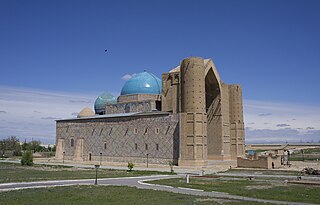
The Mausoleum of Khawaja Ahmed Yasawi is a mausoleum in the city of Turkestan, in southern Kazakhstan. The structure was commissioned in 1389 by Timur, who ruled the area as part of the expansive Timurid Empire, to replace a smaller 12th-century mausoleum of the famous Turkic poet and Sufi mystic, Khoja Ahmed Yasawi (1093–1166). However, construction was halted with the death of Timur in 1405.

Traditionally, Iranian architects were known as Mi'mars.

Pir Bakran is a city and capital of Pir Bakran District, in Falavarjan County, Isfahan Province, Iran. At the 2006 census, its population was 10,851, in 2,934 families. It is located southwest by road from Isfahan.

The Pir Huseyn Khanqah and Mausoleum lies along the left bank of Pirsaat River (Pirsaatçay), 126 kilometers to the southwest of Baku. The inscription plaque over the portal, read by V. Kratchkovskaya in 1952, announces that the khanqah was built by Sharaf al-Dawla wal-din Hasan during the reign of the Shirvanshah Afridhun Abul-Muzaffar Fariburz. The title gives a later date: "Here lies the sheikh, imam, mystic...Al-Husain, son of 'Ali, known as Pir Husain Rawanan...His tomb was rebuilt by 'Umar, son of Muhammad al-Shirzadi of Qazvin and completed in the year of 684 [1280 B.C.E.]." It is likely that the tomb of Pir Husayn bin Ali, an Azeri sheikh of the Qalandari sect who lived in the 11th century, existed on this site before a formal khanqah was built around it in the 13th century.
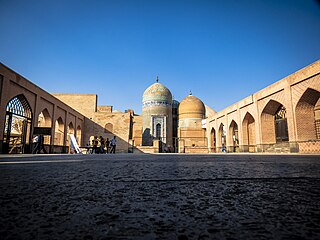
Sheikh Safi al-Din Khānegāh and Shrine Ensemble is the tomb of Sheikh Safi-ad-din Ardabili located in Ardabil, Iran. In 2010, it was registered on the UNESCO World Heritage List. This monument is situated in the Ali-Ghapu area.
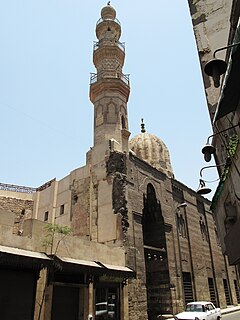
The Mosque and Khanqah of Shaykhu is an Islamic complex in Cairo built by the Grand Emir Sayf al-Din Shaykhu al-Nasiri. The mosque was built in 1349, while the khanqah was built in 1355. Shaykhu was the Grand Emir under the rule of Sultan an-Nasir Hasan.

Bagh-e-Ghoushkhane minaret(Persian: مناره باغ قوشخانه) is a historical minaret in Isfahan, Iran. This minaret dates back to the 14th century. In the olden days it was in the neighborhood of the old city gate. Because of its proximity to the Ali ebn-e Sahl mausoleum it is also known as Ali-ebn-e-Sahl minaret. Its newest famous name is Bagh-e-Ghoushkhane minaret, because of its proximity to the Ghushkhaneh garden. A part of its vertex and tiles have collapsed.

Shahshahan Mausoleum is a historical mausoleum in Isfahan, Iran. It is located beside Jameh mosque and is the burial place of a famous Sufi of Isfahan, Shah Alaeddin Mohammad. According to the date of Shah Alaeddin's death, which was in the December 1446, the mausoleum was built between 1446 and 1448. Inside and outside of the mausoleum is decorated by calligraphy, plasterwork and tiling. Its dome, which had been destroying in the recent years, has been rebuilt, but the mausoleum is still in dire need of more repair work.
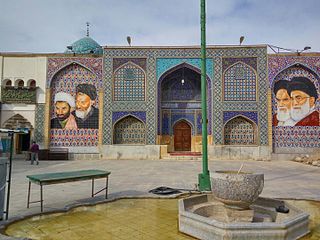
The Emamzadeh Haroun-e-Velayat, or the Harun-i Vilayat Mausoleum, is an imamzadeh in Isfahan, Iran. It is located opposite the Ali minaret in Dardasht and belongs to the Ismail I era. There are many accounts of Harun Vilayat, the person who is buried in it. Some say that he is the sixth Imam's son and others, that he is the tenth Imam's son, but aside from the matter of who is buried in it, it is the most important historical structure related to the early Safavid era. Beyond the tomb it has also a portico, a tiled dome and a large yard.

Emamzadeh Esmaeil and Isaiah mausoleum is a historical complex in Isfahan, Iran, which dates back to the Seljuk and Safavid era. This complex is located near the Jameh Mosque of Isfahan, in the Hatef street and contains two mausoleums, one believed to be for Esmaeil, one of grandsons of Hasan ibn Ali, and another which is believed to be Isaiah's.
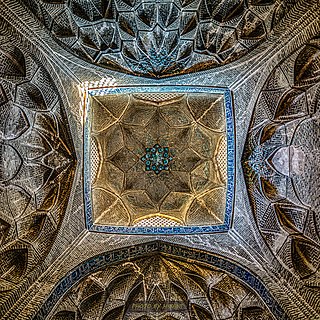
Baba Ghassem mausoleum is a historical mausoleum in Isfahan, Iran. It dates back to the 14th century. It is well known for its beautiful mihrab and dome. It is located to the north of Jameh Mosque of Isfahan. It was repaired and revamped in the Safavid era. Baba Ghassem was one of the prominent faqihs in Isfahan. One of his devotees built the Emamieh school for him, when Baba Ghassem was alive and after Baba Ghassem's death he built this mausoleum for him. The tomb has brick and tile decorations. Its dome is pyramidical. This mausoleum was very respected in the past, so that people swore to it beside the tomb for proving that they are telling the truth. On the below part of the dome of the structure, one of the names of Allah has been written in the Bannai script.
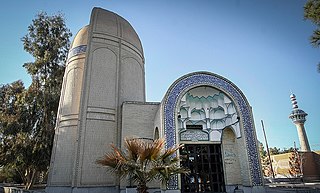
Takht-e Foulad(Persian: تخته فولاد) is a historical cemetery in Isfahan, Iran. The cemetery is at least 800 years old. In the 13th century in the Ilkhanid era Takht-e Foulad was the most important cemetery in Isfahan and all of the famous personalities have a mausoleum in this cemetery. Unfortunately all of the mausoleums from the Ilkhanid era, except Baba Rokn ed-Din mausoleum, which is the oldest structure in Takht-e Foulad, have been destroyed. In the Safavid era there were 400 mausoleums in Takht-e Foulad, but there are now only 8 mausoleums from the Safavid era. In the Qajar era a large part of the cemetery was destroyed, but the cemetery hasn't lost its importance and by the end of Pahlavi era it was the most important cemetery in Isfahan. There are 20 structures from the Qajar era and 17 structures from the Pahlavi era in the cemetery. Before the Safavid age the cemetery had been known as Lessan ol-Arz and Baba Rokn ed-Din, but from the Safavid age until now its name is Takht-e Foulad.
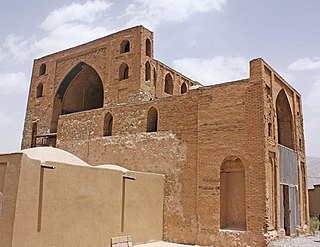
The Pir Bakran mausoleum is a historical mausoleum in Pir Bakran, the capital of Pir Bakran District. The mausoleum dates back to the Ilkhanid era. The names of The Rashidun Caliphs on its inscriptions show that the building belongs the early times of the conversion of mongols to islam and they were still sunnite. The courtyard of the mausoleum is surrounded by walls, small iwans and the arched portals of the main iwan and decorated by some inscriptions with Kufic scripts and stuccoes with the form of flowers and bushes, which are the works of Mohammad Naghash. Mohammad ebn-e Bakran's grave is located behind the courtyard. On the northern side of it, there's a small closed room, which was probably his teaching place. The mausoleum is decorated with stuccoes and tiles.

The Meydan mosque is a historical mosque in Kashan, Iran. It is located in the southern side of the Sang-e Ghadimi square and beside the Bazaar of Kashan. It is one of the oldest structures in Kashan. The primary structure belonged possibly to the seljuq era, but it was destroyed by the Mongols during their invasions. Later it was rebuilt and repaired by Khaje Emad ed-Din. A quotation for this matter is an inscription in the old mihrab, in which it is mentioned that it is built in 623 Hijri by Hassan ebn-e Arabschah in Kashan. The mihrab was in its original place until the last century, but it is kept now in the Museum of Islamic art in Berlin.

The Emamzadeh Ebrahim is a historical structure in Kashan, Iran. The Emamzadeh belongs to the Qajar era. It is well known for its turquoise dome, tiled minarets, pleasant yard and beautiful iwan. Paintings, tiles and decorations with cut mirrors have been added later in the early 20th century.

The Khaje Taj od-Din mausoleum is a historical structure in Kashan, Iran. In the 15th century, Khaje Taj od-Din, the brother of founder of Zeyn od-Din minaret, Khaje Zeyn od-Din, built a mosque with minarets and a school on the tombs of two Imamzadehs and some of his contemporary scientists and judges. In the course of time the mosque and minarets and school were destroyed and only two domes remained, which is named Khaje Taj od-Din mausoleum. The outer surface of its eastern dome has tile mosaic. Around the dome, it has been decorated with three rows of raised stucco inscriptions. The inscriptions are some poems in the Naskh and Thuluth scripts.
Abolhassan Ali ebn-e Sahl Azhar Esfahani was a Persian mystic. He lived in the era of Abbasid Caliph Al-Mu'tadid and died in 894 in Isfahan. According to Spencer, he founded the first khanqah. His khanqah still exists and is also his mausoleum.

The Emamieh school is a historical school in Isfahan, Iran. The school belongs to the 14th century and was built by the order of Soltan Abolhassan Talout Damghani. He built the school for his teacher Baba Ghassem Esfahani. The building was tiled by the Sheikh Mohammad ebn-e Omar, whose name was mentioned on the inscriptions of the school.

The Jameh Mosque of Golpayegan is one of the important mosques of the Seljukid era and one of the large mosques in Iran. In view of its construction date, it may be said that its Iranian Islamic architecture was a model for building other large mosques specially the mosques, which were in the territory of seljukid dynasty. This mosque is located in the Masjed Jameh street in Golpayegan.

The Madrasa of Amir Sunqur Sa'di, also commonly known as the Mausoleum of (Sheikh) Hasan Sadaqa, is a medieval Mamluk-era madrasa structure and mausoleum in Cairo, Egypt. It was originally built between 1315 and 1321 CE by amir Sunqur Sa'di. Sunqur was forced to leave Egypt in his lifetime and was never buried there, but a sheikh known as Hasan Sadaqa was later buried in it and therefore the building is often known by his name. From the 17th century onward the complex was converted into Mevlevi Sufi lodge and is open today as the Mawlawiyya Museum or Museo Mevlevi.

















